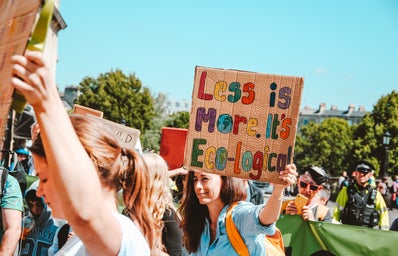Anyone who knows me knows I’m a sucker for all things sustainable (hello, environmental science major), but honestly, what does that even mean? “Sustainability” has become the new buzzword for companies to promote their products to an increasingly eco-conscious audience, but for someone out of the loop, it can get pretty overwhelming. How do you know who’s really backing their lofty claims, like making dresses out of recycled plastic or planting one tree for every purchase? Are these products really worth the extra dollars and are they really going to help the planet? This is where I come in to tell you yes—there are ways you can channel your inner Greta Thunberg and do it on a college student’s budget.
To make it a little easier, I decided to break down a few of my favorite sustainable swaps across three categories: hygiene, home, and clothes. You don’t need to be doing all these things to be a more conscious consumer, but just getting started will absolutely make a difference, not just for the planet, but also for your bank account.
Hygiene
Thanks to spring break, I decided to try out a sample of the toothpaste tabs from Huppy to save some room in my carry-on. I’ll preface by saying that this is the one swap on here that isn’t much of a cost-saver, but I really liked having them for traveling and the flavors were super yummy.
On the other hand, one swap that has been saving me some dough over the last few years is using reusable cotton pads to take off my makeup. I’ve had a 4-pack for over a year now that I just wash with my laundry, and I SWEAR I’m losing fewer eyelashes than I was before. If you’re feeling extra ~sustainable~ you can even sew your own from old fabrics/clothes/socks/etc.
Home
I love a good set of cute dish towels, and it definitely helps me to avoid using soooo many paper towels. You can get them practically anywhere for a low price, but if you’re looking for towels made from sustainable materials, you should keep an eye out for labels with bamboo, hemp, or organic cotton. While these materials might be more expensive up front, you’re saving by no longer having to buy paper towels every month.
Another sneaky cost saver is cutting back on electricity consumption. Wool dryer balls trap heat as they move around in the dryer to help air circulate and cut down on drying time. I’d been wanting to try them for so long, so I got my family some from Friendsheep Wool for Christmas and they are literally SO cute. I’ve definitely noticed a difference in how long it takes my clothes (and even my gigantic comforter) to dry.
Clothes
Many of us are learning that we should avoid fast fashion and shop secondhand to be more sustainable when buying clothes, but there’s a little more to it than that. If you’re buying fast fashion to save money, that’s totally cool. Spending $500 on a Shein haul when you could’ve bought from Patagonia or Everlane is not. So, one swap I’ve been working on is trying to buy my statement pieces secondhand instead of brand new. Try hitting up Poshmark or your local thrift shop for cozy fleeces, chic leather jackets, or a funky pair of boots. Everybody loves a lil’ thrifted moment.
Another swap that occurred to me recently was period underwear—please, hear me out. I haven’t bought any yet, so I can’t vouch for it, but I’m pretty confident it would be much more comfortable for those lighter days, and it’s sustainable because you don’t have to waste any pads or tampons or worry about them going to a landfill.
So, try some of these swaps the next time you’re out and about. Remember, true sustainability means buying as little as possible, so focus on the things you really need and not all the things you want.


